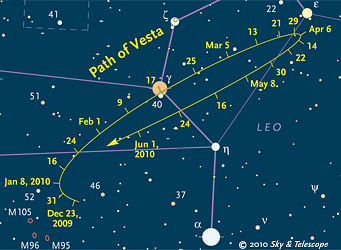On spring evenings Leo climbs high in the eastern sky. Leo’s forequarters form the landmark Sickle asterism, and in and around the Sickle this season lurks the most prominent asteroid in the sky: 4 Vesta. Although Vesta is not the largest asteroid, it generally becomes the brightest around its season of opposition; its unique surface material is less dark colored than most of the stuff in the asteroid belt.

Click on the map above for a full-page printable PDF version. (The tick marks are for 0 hours Universal Time on the dates indicated. This moment falls on the evening of the previous date in the time zones of the Americas.)
Tony Flanders
Vesta reaches opposition on the night of February 17–18, when it will shine at magnitude 6.1. (Notice that, as you’d expect, this date comes halfway through Vesta’s retrograde loop on the map here.) Using the map, you can follow Vesta starting immediately. It’s magnitude 7.2 on January 1st, 6.4 on February 1st, 6.2 on March 1st, 6.8 on April 1st, 7.3 on May 1st, and back down to 7.7 on June 1st. That means it’s in binocular range for the whole time.
A very special coincidence happens right around opposition. Between the evenings of February 15th and 16th for the Americas, Vesta threads the gap between Gamma Leonis (magnitude 2.5) and 40 Leonis (magnitude 4.8), which is located 22 arcminutes to Gamma’s south. This familiar binocular pair will have a faint new interloper! Watch the asteroid’s progress from night to night — or even, with a telescope, from hour to hour. Around those dates Vesta is moving northwestward by 1 arcminute in a little less than 2 hours — or, at high magnification, 1 arcsecond in a little less than 2 minutes of time.
Click here for a full-page printable chart in PDF format showing Vesta's path through the "fixed" stars in 2010. Date ticks on the chart are for 0 hours Universal Time; this falls on the evening of the previous date in the time zones of the Americas.
 1
1









Comments
Jeff
February 17, 2010 at 3:19 pm
I was able to observe Vesta on the evening of 16 February, at 22h20m UT, when it was almost directly in between Algieba and 40 Leo. A great sight, and I was surprised at how bright it was. Very easy to see in 8x56 binoculars. http://www.users.waitrose.com/~spa/Images/20100216-22h20m-Vesta.png
One thing I did notice, aside from its brightness, was that there appeared to be an almost subtle light orange colouration to the asteroid. I'm not sure if this was my eyes playing tricks on me, or if this really is the case.
You must be logged in to post a comment.
You must be logged in to post a comment.